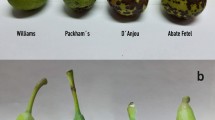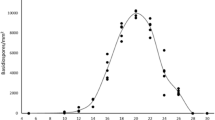Abstract
Stripe rust (Yellow rust) caused by Puccinia striiformis f. sp. tritici (Pst) is a major disease of wheat worldwide. The use of resistant cultivars to control Pst has been very effective, low-cost, and ecologically sound. However, virulence patterns of Pst can quickly change, which may render resistant cultivars susceptible. The discovery of infection of Berberis spp. by basidiospores of Pst in 2010 raised important concerns about the evolution of new virulent races of the pathogen. Little is known about the infection process of Berberis spp. by basidiospores of Pst and the interaction between Berberis spp. and asexual urediniospores. In this study, the interaction between Pst urediniospores and Berberis spp. was investigated at histological and cytological levels. Our results indicate that Berberis spp. expresses a continuum of layered defenses comprised of structural and chemical changes in the cell wall as well as post-haustorial hypersensitive responses to urediniospore infection. Our study also re-examines in detail the infection process of Pst basidiospores on Berberis spp. and provides useful information for further research on the molecular mechanisms governing the interaction between Berberis spp. and Pst.






Similar content being viewed by others
References
Allen EA, Hoch HC, Steadman JR, Stavely RJ (1991) In: Andrews JH, Hirano SS (eds) “Influence of leaf surface features on spore deposition and the epiphytic growth of phytopathogenic fungi”, in microbial ecology of leaves. Springer Verlag, New York, pp 87–110
Apostol I, Heinstein PF, Low PS (1989) Rapid stimulation of an oxidative burst during elicitation of cultured plant cells role in defense and signal transduction. Plant Physiol 90:109–116
Ayliffe M, Devilla R, Mago R, White R, Talbot M, Pryor A, Leung H (2011) Nonhost resistance of rice to rust pathogens. Mol Plant-Microbe Interact 24:1143–1155
Bux H, Rasheed A, Siyal MA, Kazi AG, Napar AA, Mujeeb-Kazi A (2012) An overview of stripe rust of wheat (Puccinia striiformis f. sp. tritici) in Pakistan. Arch Phytopathol Plant Protec 45:2278–2289
Chen X (2005) Epidemiology and control of stripe rust (Puccinia striiformis f. sp. tritici) on wheat. Can J Plant Pathol 27:314–337
Cheng Y, Zhang H, Yao J, Han Q, Wang X, Huang L, Kang Z (2013) Cytological and molecular characterization of non-host resistance in Arabidopsis thaliana against wheat stripe rust. Plant Physiol Bioch 62:11–18
Cheng Y, Zhang H, Yao J, Wang X, Xu J, Han Q, Wei G, Huang L, Kang Z (2012) Characterization of non-host resistance in broad bean to the wheat stripe rust pathogen. BMC Plant Biol 12:96
Dean R, Van Kan JA, Pretorius ZA, Hammond-Kosack KE, Di Pietro A, Spanu PD, Rudd JJ, Dickman M, Kahmann R, Ellis J (2012) The top 10 fungal pathogens in molecular plant pathology. Mol Plant Pathol 13:414–430
Gold RE, Mendgen K (1984) Cytology of basidiospore germination, penetration, and early colonization of Phaseolus vulgaris by Uromyces appendiculatus var. appendiculatus. Can J Bot 62:1989–2002
Gray D, Amerson H, Van Dyke C (1983) Ultrastructure of the infection and early colonization of Pinus taeda by Cronartium quercuum formae speciales fusiforme. Mycologia 75:117–130
Heath MC (1974) Light and electron microscope studies of the interactions of host and non-host plants with cowpea rust-Uromyces phaseoli var. vignae. Physiol. Plant Pathol 4:403–414
Heath MC (1979) Partial characterization of the electron-opaque deposits formed in the non-host plant, French bean, after cowpea rust infection. Physiol Plant Pathol 15:141–148
Hood M, Shew H (1996) Applications of KOH-aniline blue fluorescence in the study of plant-fungal interactions. Phytopathology 86:704–708
Hoogkamp T, Chen WQ, Niks R (1998) Specificity of prehaustorial resistance to Puccinia hordei and to two inappropriate rust fungi in barley. Phytopathology 88:856–861
Jacobi W, Amerson H, Mott R (1982) Microscopy of cultured loblolly pine seedlings and callus inoculated with Cronartium fusiforme. Phytopathology 72:138–143
Jin Y (2011) Role of Berberis spp. as alternate hosts in generating new races of Puccinia graminis and P. striiformis. Euphytica 179:105–108
Jones JD, Dangl JL (2006) The plant immune system. Nature 444:323–329
Kang Z, Huang L, Buchenauer H (2002) Ultrastructural changes and localization of lignin and callose in compatible and incompatible interactions between wheat and Puccinia striiformis. J Plant Dis Prot 109:25–37
Koch K, Bhushan B, Barthlott W (2009) Multifunctional surface structures of plants: an inspiration for biomimetics. Prog Mater Sci 54:137–178
Kohno M, Nishimura T, Noda M, Ishizaki H, Kunoh H (1977) Cytological studies on rust fungi. (VII) The nuclear behavior of Gymnosporangium asiaticum Miyabe et Yamada during the stages from teliospore germination through sporidium germination. Transac Mycol Soc Jap 18:211–219
Lipka U, Fuchs R, Lipka V (2008) Arabidopsis non-host resistance to powdery mildews. Curr Opin Plant Biol 11:404–411
Metzler B (1982) Untersuchungen an Heterobasidiomyceten (23): Basidiosporenkeimung und Infektionsvorgang beim Birnengitterrost. Phytopathol Z 103:126–138
Mims CW (1977) Fine structure of basidiospores of the cedar-apple rust fungus Gymnosporangium juniperi-virginianae. Can J Bot 55:1057–1063
Mittler R, Vanderauwera S, Gollery M, Van Breusegem F (2004) Reactive gene network of plants. Trends Plant Sci 9:490–498
Niks R (1982) Early abortion of colonies of leaf rust, Puccinia hordei, in partially resistant barley seedlings. Can J Bot 60:714–723
Niks R (1983a) Comparative histology of partial resistance and the nonhost reaction to leaf rust pathogens in barley and wheat seedlings. Phytopathology 73:60–64
Niks R (1983b) Haustorium formation by Puccinia hordei in leaves of hypersensitive, partially resistant, and nonhost plant genotypes. Phytopathology 73:64–66
Nusbaum CJ (1935) A cytological study of the resistance of apple varieties to Gymnosporangium juniperi-virginianae. J Agric Res 51:573–596
Schulze-Lefert P, Panstruga R (2011) A molecular evolutionary concept connecting nonhost resistance, pathogen host range, and pathogen speciation. Trends Plant Sci 16:117–125
Thordal-Christensen H (2003) Fresh insights into processes of nonhost resistance. Curr Opin Plant Biol 6:351–357
Thordal-Christensen H, Zhang Z, Wei Y, Collinge DB (1997) Subcellular localization of H2O2 in plants. H2O2 accumulation in papillae and hypersensitive response during the barley-powdery mildew interaction. Plant J 11:1187–1194
Voegele RT, Struck C, Hahn M, Mendgen K (2001) The role of haustoria in sugar supply during infection of broad bean by the rust fungus Uromyces fabae. Proc Nat Acad Sci USA 98:8133–8138
Wang CF, Huang LL, Buchenauer H, Han QM, Zhang HC, Kang ZS (2007) Histochemical studies on the accumulation of reactive oxygen species (O2− and H2O2) in the incompatible and compatible interaction of wheat-Puccinia striiformis f. sp. tritici. Physiol Mol Plant Pathol 71:230–239
Wang CF, Huang LL, Zhang HC, Han QM, Buchenauer H, Kang ZS (2010) Cytochemical localization of reactive oxygen species (O2− and H2O2) and peroxidase in the incompatible and compatible interaction of wheat–Puccinia striiformis f. sp. tritici. Physiol Mol Plant Pathol 74:221–229
Yang Y, Zhao J, Xing H, Wang J, Zhou K, Zhan G, Zhang H, Kang Z (2014) Different non-host resistance responses of two rice subspecies, japonica and indica, to Puccinia striiformis f. sp. tritici. Plant Cell Rep 33:423–433
Zhang H, Wang C, Cheng Y, Chen X, Han Q, Huang L, Wei G, Kang Z (2012) Histological and cytological characterization of adult plant resistance to wheat stripe rust. Plant Cell Rep 31:2121–2137
Zhao J, Wang L, Wang Z, Chen X, Zhang H, Yao J, Zhan G, Chen W, Huang L, Kang Z (2013) Identification of eighteen Berberis species as alternate hosts of Puccinia striiformis f. sp. tritici and virulence variation in the pathogen isolates from natural infection of barberry plants in China. Phytopathology 103:927–934
Zhao J, Zhang HC, Yao JN, Huang LL, Kang ZS (2011) Confirmation of Berberis spp. as alternate hosts of Puccinia striiformis f. sp. tritici on wheat in China. Mycosystema 30:895–900
Acknowledgements
This study has been financially supported by the National Key Basic Research Program of China (2013CB127700), the National Natural Science Foundation of China (31371889), Research Fund for the Doctoral program of Higher Education of China (20130204110001), the Program for New Century Excellent Talents in University (NCET-12-0471), and the 111 Project from the Ministry of Education of China (B07049). The authors thank Professor Larry Dunkle from the USDA-Agricultural Research Service at Purdue University, USA, for critical reading of the manuscript.
Author information
Authors and Affiliations
Contributions
JuG and ZK designed experiments; MJ performed the experiments; CT and LW analyzed the data; HZ and JiG joined the discussion and gave the original ideas; and MJ, JuG, and ZK wrote the paper.
Corresponding authors
Ethics declarations
Conflict of interest
The authors declare that they have no conflict of interest
Additional information
Handling Editor: Adrienne R. Hardham
Rights and permissions
About this article
Cite this article
Jiao, M., Tan, C., Wang, L. et al. Basidiospores of Puccinia striiformis f. sp. tritici succeed to infect barberry, while Urediniospores are blocked by non-host resistance. Protoplasma 254, 2237–2246 (2017). https://doi.org/10.1007/s00709-017-1114-z
Received:
Accepted:
Published:
Issue Date:
DOI: https://doi.org/10.1007/s00709-017-1114-z




